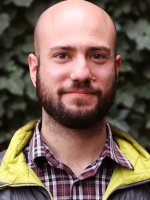Three women in their 80s and 90s sat around a table together last month, taking swipes at a bright yellow balloon emblazoned with a smiley face.
Margaret Clark, Diane Chisholm and Betty Doyle are residents at New Hope Valley, an assisted living facility just outside Saginaw.
Their game of keep-the-balloon-off-the-floor was overseen by Jamie Capp, who said it was a bit of physical therapy to get upper-body muscles moving and practice hand-eye coordination.
But Clark, Chisholm and Doyle have only recently been able to start playing this game again.
As COVID-19 swept through Michigan’s long-term care facilities, thousands of residents died. Staff and administrators at those homes said people who lived were forced by the pandemic into an isolated existence with little contact with anyone outside of their rooms.
“It took a toll on them,” Capp said. “They want to be out and socializing.”
She said she saw a decline in mental and physical health in the population that was now vulnerable both to the virus and to loneliness.
Video calls through Skype and FaceTime helped, but they’re nowhere near as good for the psyche as real, physical contact, said Capp.
“They need to be physically with their families,” she said.
And now, finally, they can. One of the residents who’s seen her family in person for the first time in months is Anna Provenzano, who turns 91 this month.

She said she spent months in her small apartment with almost no human contact and nothing to do.
To pass the time, she watched movies on the Hallmark channel.
“I know every Hallmark movie that was ever made,” she said. “You want to know the end? They kiss. Every movie.”
As soon as a vaccine became available, Provenzano jumped at the chance to get it. She’s now among the 98 percent of residents at New Hope Valley who the facility said were vaccinated.
The home’s managing director, Rumi Shahzad, said there’s a narrow balance between opening the facility up and keeping residents there safe while COVID-19 was still spreading outside.
“The focus is on making sure that we bring life for the residents back to almost normalcy, without taking a risk in terms of their wellbeing and safety,” Shahzad said. “That’s a very difficult walk to walk.”
Despite that almost all of the residents at New Hope Valley were vaccinated, only about 60 percent of the staff had gotten their shots.
Shahzad said that number was slowly creeping up as people who were hesitant saw their colleagues and their families and friends get vaccinated without problems.
“Some have come around, and I’m hoping that more of them will come around as the year progresses,” he said.
Shahzad’s optimism is a pretty common feeling among administrators at long-term care facilities, said Melissa Samuel, the CEO of the Health Care Association of Michigan, which represents assisted living and nursing homes in the state.
Samuel said people do change their minds, especially in the field of long-term care.
“It’s all about education. Definitely out of the gate, particularly with staff, I think there was hesitancy,” she said. “Now, we’re starting to really get some good information out there. We’re getting some good public service. We’re getting leaders in the community.”
New Hope Valley has resumed many of the activities that were on hold until vaccination rates rose, like exercise classes (“We sat so much this last year that it feels very good to move again,” said Betty Therrien at the end of a session) and craft lessons (“I’m frustrated by the double-knots, but it’s nice to be able to get out and be with other people,” said Lola Lemmer).

But as they start getting back to normal, many of the home’s residents wonder why their vaccination rates are so much higher than the rest of the state’s population. Some people at New Hope Valley who spent months in near solitude waiting for vaccines to be developed, tested, and authorized can’t fathom why anyone wouldn’t get the shots.
Larry Mey, an 85-year-old retired pharmacist, said he got his doses as soon as he could.
“I’m disappointed that some people say they don’t want to get vaccinated because they’re afraid. There’s nothing to fear,” he said.
Mey has seen the roll-out of other new vaccines for diseases like chicken pox and pertussis, and he said he wants residents and staff here who have gotten a COVID-19 vaccine to tell their friends and families. He said showing people that the new vaccine is normal and safe is what will help it become accepted.





